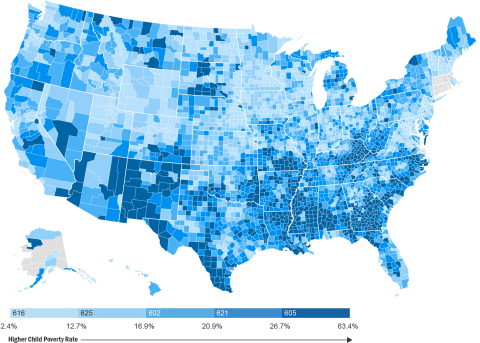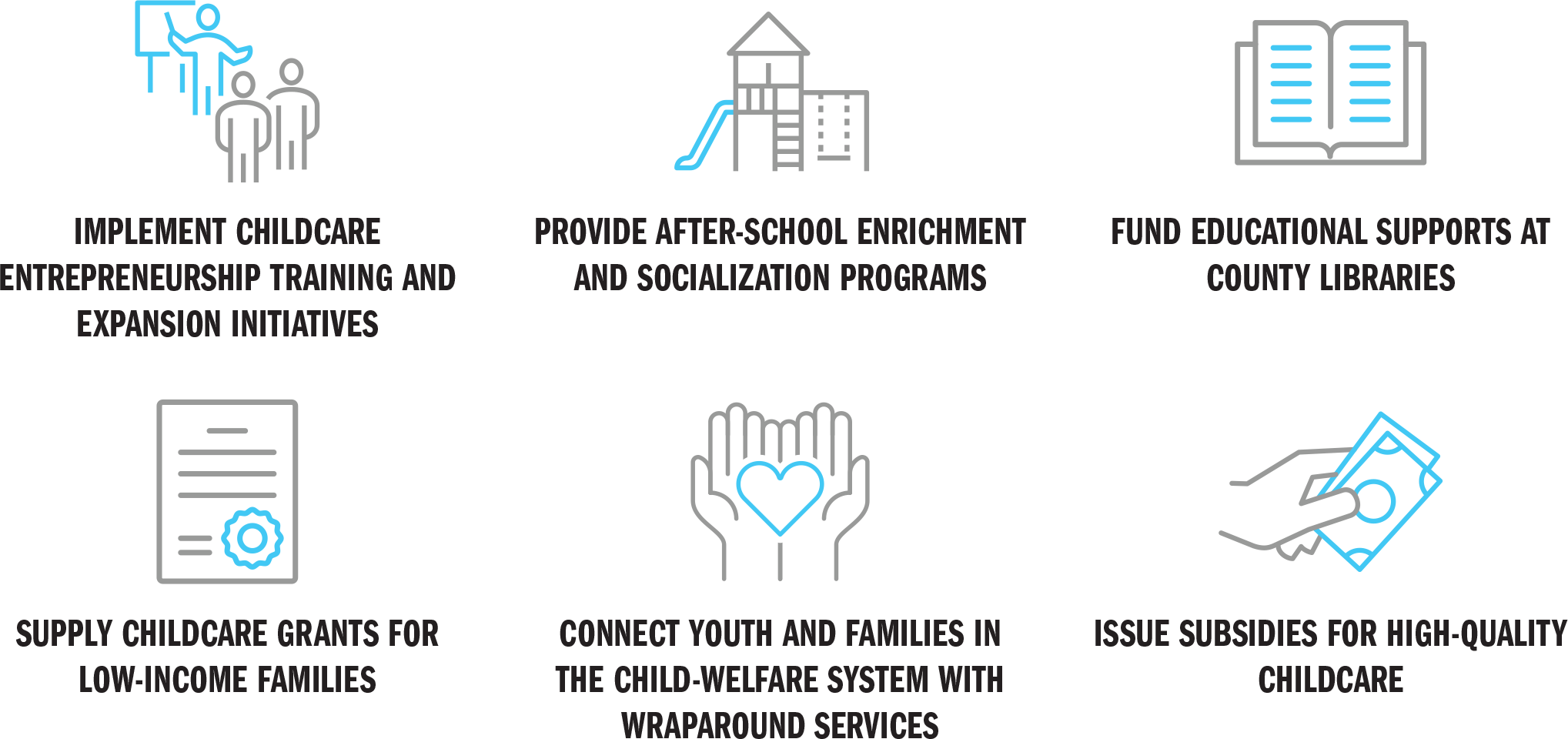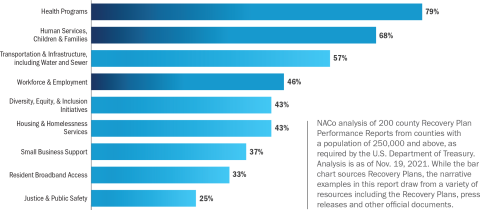Counties and the American Rescue Plan Act Recovery Fund: Children and Families

Upcoming Events
Related News
Child Poverty is a Pressing Issue Across the Nation
Across the nation, child poverty continues to be a pressing issue. In 2019, over 70 percent of counties had a child poverty rate that exceeded the national average.

Map: 2019, U.S. Census Bureau, Small Area Income and Poverty Estimates; U.S. Census Bureau, American Community Survey 2015-2019 5-year Estimates.
Counties Plan to Invest Recovery Funds to:

Counties are Prioritizing Children & Families Through Key Investments
How will counties invest the funds? NACo analysis of 200 county ARPA Recovery Fund plans reveals county- designed investments in the community across key areas of need. These local priorities are found within county plans at the rate displayed in the chart, e.g. sixty-eight percent of county plans include investments in human services, children and families. The darker bars are the investment categories adjacent to children and families that support the continuation and expansion of services in counties. The examples in this report further illustrate the allocations to support children and families on the local level.

Collier County, Fla.

Collier County is expanding the Community Outreach, Literacy and Education (COLE) program to support youth literacy development that was interrupted due to the pandemic. The county has allocated $2.6 million in Recovery Funds to provide three educational sessions per week at county libraries that operate in undeserved parts of the community, also known as Qualified Census Tracts, with the aim to improve educational outcomes for local students.
Cumberland County, Maine

Cumberland County is utilizing Recovery Funds to develop a workforce training program for childcare providers to expand capacity. The county will collaborate with state and regional partners to develop a child entrepreneurship training initiative that will fill in gaps in service that were worsened during the pandemic. These funds will also focus on childcare in marginalized communities that do not have adequate access.
Deschutes County, Ore.

Deschutes County is assisting residents with their return-to-work by expanding childcare access. Through a $1 million investment in Recovery Funds, the county will support the Little Kits Early Learning & Child Care Center project and provide childcare for an additional 70 to 100 children in Bend during the first phase.
Dutchess County, N.Y.

Dutchess County is addressing broader learning loss from the pandemic through a $3 million “Learn, Play, Create” grant program. The program will invest in youth-serving organizations that promote learning, art enrichment and sports activities. Additionally, the county allocated $10 million to build a Youth Opportunity Center that will bring evidence-based programs and services together to promote healthy childhood environments and build a stronger neighborhood that will support lasting recovery.
Gloucester County, N.J.

Gloucester County is providing wraparound supports for youth by investing in programs that assist family members struggling with mental health or substance use disorder. Given the increased incidences of these issues during the pandemic, the county has identified the need for additional support in this area. The project will utilize $100,000 in Recovery Funds and be driven by the Youth Impacted by Addiction Coalition which provides care and assistance to children 3 to 17 years of age who have been impacted by a loved one’s substance use. An additional $150,000 is also allocated to provide trauma-informed care training for educators.
Howard County, Md.

Howard County has allocated approximately $15 million to address COVID-19’s negative economic impacts and $10 million to fund services for disproportionately impacted communities. Within those funding categories, the county will focus on children and families as a key priority to fully address the breadth of economic challenges residents continue to face during the pandemic. Funds will support childcare providers, implement educational enhancement programming for children and finance additional childcare support services.
Jefferson County, Mont.

Jefferson County aims to increase the amount of affordable, high-quality childcare available to residents as the county continues to recover from the COVID-19 pandemic. The county will use $100,000 in Recovery Funds to address urgent needs of childcare providers struggling to survive or re-open under pandemic conditions.
New York City, N.Y.

New York City will continue to provide educational supports for young children, including the Learning Labs program which offers free childcare options for children in Pre-K through 8th grade enrolled in blended or remote learning models. This $83.9 million investment is essential to help families manage the continued impact of COVID-19 on their children’s education. Another $67.7 million is devoted to youth programming initiatives and specifically assists community-based organizations develop high quality sports programming to provide more opportunities for socialization.
Oakland County, Mich.

Oakland County is supporting youth development by investing $2.9 million in 12 new career centers that will help students understand their skills and potential training paths. An additional $1.2 million is allocated for enhanced child welfare services, with a focus on childcare grants to households where obtaining childcare continues to be a barrier to employment or re-employment following the pandemic.
Travis County, Texas

Travis County is taking a multi-faceted approach to childcare assistance by growing the capacity in the area through increasing funds for subsidies, expanding contracts with partner organizations, piloting a non-traditional work hours childcare program and providing wage supplements for employees in the childcare workforce. These initiatives are supported by a $2.4 million allocation from the Recovery Fund, and aim to both assist families in need and bolster the county’s workforce, both of which are priorities set forth by ARPA.
Washtenaw County, Mich.

Washtenaw County is committed to equitably addressing childcare access needs through providing navigation and financial assistance services for low-income families. The county will also match the $1 million investment through the county general fund. The funding aims to address systemic disparities related to high-quality childcare access and supplement the reduced capacity of current school programming in light of COVID-19’s continued impact.
York County, Pa.

York County has broadly allocated $1.1 million for early learning assistance, $264,000 for childcare, $60,000 for services to foster youth/families involved in the child welfare system and $239,000 for other youth programming in the county. The county is connecting with community partners, including Big Brothers Big Sisters, Girls Scouts, Boy Scouts and the YMCA, who work directly with residents. The county seeks to leverage Recovery Funds through these allocations to support lasting investments in the county’s future beyond COVID-19.









